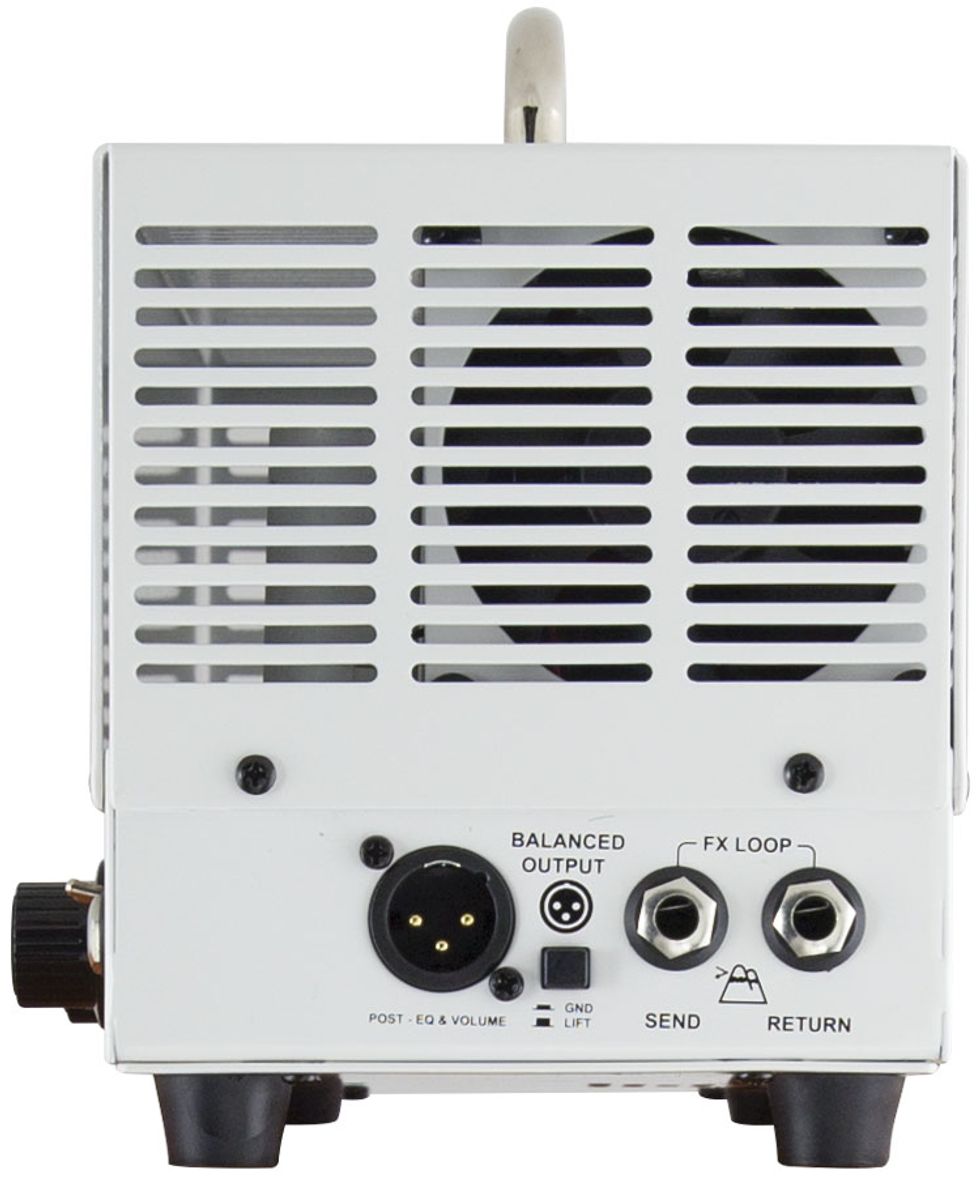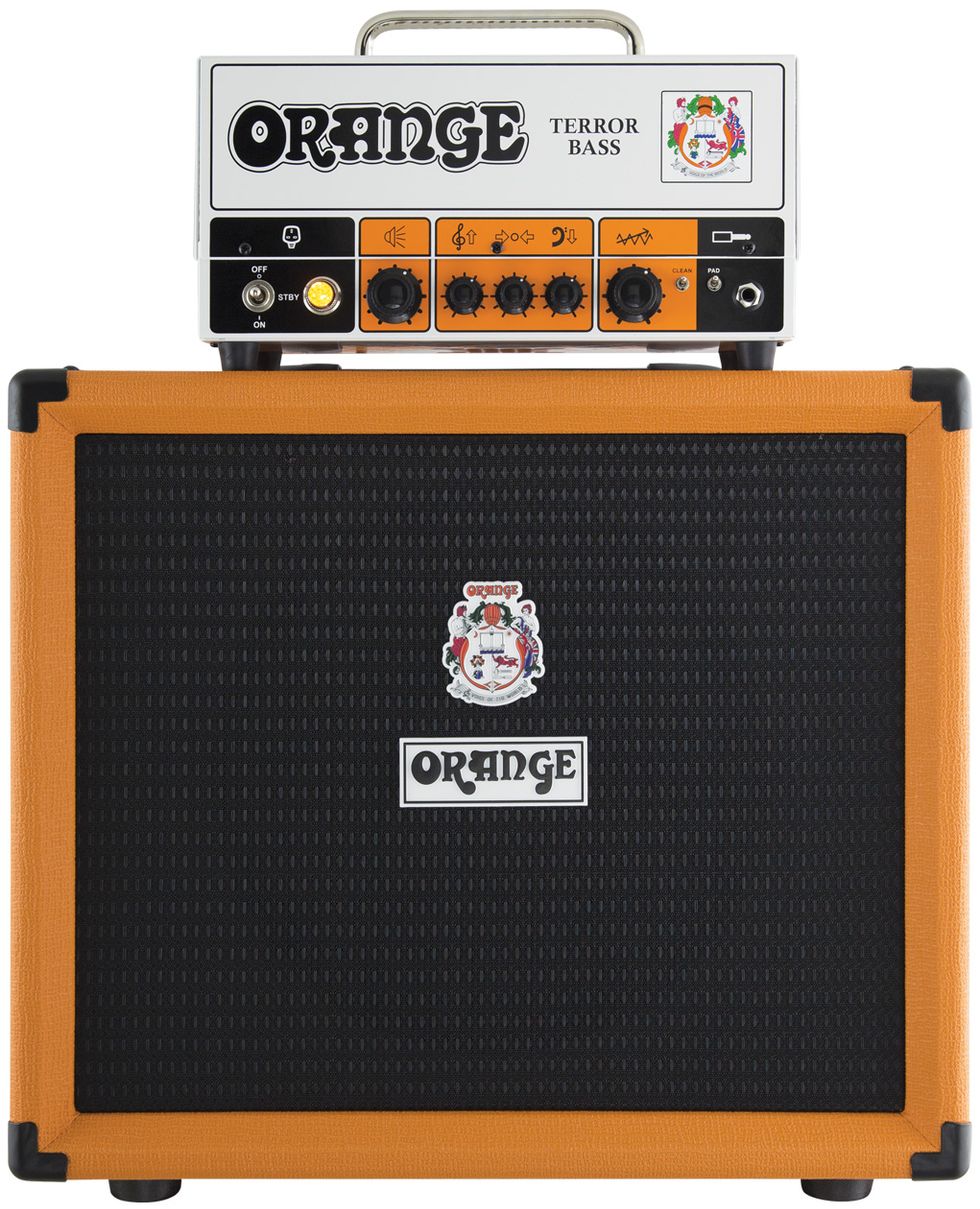Clip 1: Hofner Club bass. Dirty setting, low EQ bump, gain pushed.
Clip 2: ‘78 Fender P. Clean setting and all EQ at noon.
Clip 3: ‘78 Fender P. Dirty setting with mid bump and gain dimed.
RatingsPros:Small, powerful, and easy to navigate. Cons: Pricey. DI isn’t available both pre and post EQ. Overdrive comes up a little short. Street: $799 Orange Terror Bass orangeamps.com | Tones: Ease of Use: Build/Design: Value: |
What can I write about Orange amplifiers that hasn’t already been written? I mean, the brand is iconic, their tones distinct, and, boy, they sure look cool. As far as gear releases are concerned, Orange has always blazed its own path. They launched the Tiny Terror guitar amp, which tilted the guitar planet on its axis by offering a boutique-like head with a small footprint and huge tone—making it a studio darling. It was the Tiny Terror that set the stage for the Terror Bass line, a short-lived run of bass heads offered in the same lunchbox configuration. Today, we’re looking at the rebirth (of sorts) of the Terror Bass: a new 500-watt, class-D head that we took for a ride with one of the company’s brand-new cabinets.
Terror to the Left of Me, DI to the Right
The Terror Bass is something to behold. I grew up on big, heavy rectangles called bass amps, and they were always a pain to get to upstairs rehearsal spaces. I don’t want to call the 10-pound bass head tiny, because it is about the size of a tall loaf of bread. But again, Orange cuts its own path in the crowded bass-amp woods and comes up with an amp that is neither micro nor macro.
If the 500 watts of class-D power are the meat in the sandwich (or portabella mushroom, for you healthier folks), then the preamp would be the secret sauce. Some manufacturers in the micro-bass-amp world are happy with just a power section. Orange, however, has included a tube preamp—with both a 12AT7 and a 12AX7 installed—to give that added depth and sweetness that makes a bass tone whole.
There are only a handful of controls on the front, and these tone-shapers are marked with the usual glyphs that always adorn Orange’s panels. Next to the indicator light is a large volume dial followed by a 3-band EQ with bass, mid, and treble controls. After the EQ is the preamp’s gain dial, which rests next to a mini toggle that switches between dirty and clean settings. Rounding out the front panel is the 1/4" instrument input and a 6 dB pad switch for active basses.
The rear panel houses just the AC input, speaker-impedance switch, and speaker outs, which are Speakon connections and switchable between 4 and 8 ohms depending on load. The amp’s side panel contains an XLR balanced output that’s post EQ and volume, the effects loop, and a ground-lift switch. So, if you consider housing the Terror Bass head in a dedicated case, rather than the included travel bag, make sure you accommodate for the side panel.

Orange also sent us an OBC112 cabinet to pair with the Terror Bass. This new 1x12 is a rear-ported cab rated at 400 watts (at 8 ohms), and weighs around 25 pounds. When paired with the Terror Bass, it makes a rig that can shake a room with no issue, yet still fit in a Smart car. And when teaming up the Terror Bass with a pair of OBC112s, a player will get the full 500-watt output from the amp at 4 ohms.
Scare up That Tone
For the tone test, I used both a ’78 all-original Fender Precision and a Höfner Club. With the P, I set the volume and all three bands of EQ at noon (halfway), the gain halfway, and selected the clean setting. The P bass and the Terror were a fine match and provided all the power I could want. The amp’s tones were a great reproduction of my bass without too much coloration to speak of. Rolling up the gain control added just a little dirt to the mixture, even with the switch on the clean setting. I experimented with some different EQ configurations and found that by setting the mids higher than I would normally (around 80 percent), the amp sparked an aggressive rock tone sure to blast through any mix.
Sticking with the P, I went in for the dirty setting. I have to admit that I was a little disappointed with the dirt factor here. When I dimed the gain and boosted the mid for shape, the tone was solid enough, but the amp doesn’t go full-bore nasty as, say, their OB1.
RatingsPros:Lightweight and big sounding. Cons: Like its partner, pricey. Street: $529 Orange OBC112 orangeamps.com | Tones: Versatility: Build/Design: Value: |
That being said, the Terror Bass also doesn’t let you get into trouble, since it keeps the OD tones just short of chainsaw and the EQ usable from zero to 10. The EQ definitely helps the dirt factor in the Terror Bass, and I found that a mid and bass boost was a necessity for its effectiveness.
Next up was the Höfner Club, and from the moment I plugged in I was in heaven. The P sounded good, but the Höf sounded great. The clean setting gave me the vibe nuances of the hollowbody bass, and with the thick sound of the Orange, you are the star of any reggae fest. It was the tempered grit of the dirty boost paired with the Höfner, however, that would be the tone I’d track with all day, every day. The searing tone cuts through with just enough in all the right places. So, give me this setup and I am playing any gig.
The Verdict
The Terror Bass straddles the line between a big, beefy amp and a micro head, and has unique characteristics of both. The amp is powerful, and I like the compact footprint and simple, straight-ahead approach of the controls. Not having pre/post control with the DI worries me, however, since that means the bassist is in charge of the signal, which can lead to trouble. I’d also love to have the clean and dirty settings switchable via footswitch, although that might give FOH engineers fits because, once again, the DI is post EQ and level, and the dirty setting is louder than the clean. As far as the OBC112 cabinet, I was impressed with its air movement and how it makes for such a nice and tidy little rig with the Terror Bass. If one can put on his orange-colored glasses and look past a couple minor flaws, she or he will be getting a powerful rig for both live gigs and recording, and one that will both shake the timbers and save on chiropractor visits.








![Rig Rundown: AFI [2025]](https://www.premierguitar.com/media-library/youtube.jpg?id=62064741&width=1245&height=700&quality=70&coordinates=0%2C0%2C0%2C0)












 Shop Scott's Rig
Shop Scott's Rig


![Rig Rundown: Russian Circles’ Mike Sullivan [2025]](https://www.premierguitar.com/media-library/youtube.jpg?id=62303631&width=1245&height=700&quality=70&coordinates=0%2C0%2C0%2C0)












































